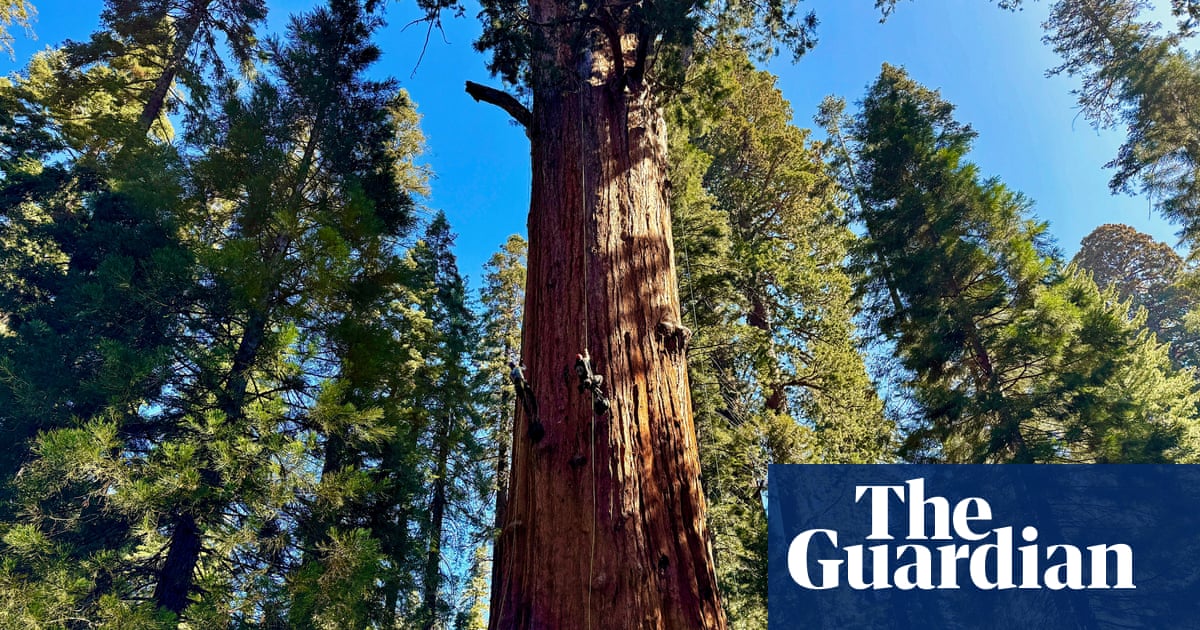The giant sequoia is so enormous that it was once believed to be indestructible. High in California’s southern Sierra Nevada mountains, the oldest trees – known as monarchs – have stood for more than 2,000 years.
Today, however, in Sequoia national park, huge trunks lie sprawled on the forest floor, like blue whale carcasses stranded on a beach. Many of these trees were felled by a combination of drought and fire. But among the factors responsible for the rising toll is a tiny new suspect: the bark beetle.
Along with wildfires and rising temperatures, scientists fear that the insects could contribute to the breakdown of Earth’s northern conifer forests, including the potential dieback of the taiga, the vast ecosystem that stretches across Canada, Scandinavia, Siberia and Alaska.
The boreal forest spans 11.3m sq km (2,800m acres) and stores about 272 gigatonnes of carbon. Its possible collapse is considered a climate tipping point: the moment when an ecosystem that was previously a carbon store flips over to releasing huge amounts of carbon instead – through a forest fire, or the gases released by decaying trees and eroding soil.
“This is a global phenomenon but it is also a complicated story,” says Prof Diana Six, a forest entomologist at the University of Montana. “You have different beetles in different forests with different behaviour.
“The only commonality, and the reason we are seeing so many incidents all at once, is the influence of humans. Climate change is the main one, but we’ve also changed forests a lot.”
Scientists are careful not to stigmatise the beetle. They are highly specialised – most of their kind have no effect on their tree hosts – but researchers are sure that their impact is growing.
In Canada, just one species, the mountain pine beetle, affected 200,000 sq km – an area almost the size of Uganda – between 2000 and 2020, with other species causing outbreaks elsewhere across the country.
In Europe, forest disturbances from bark beetles have soared, particularly affecting Norwegian spruce monocultures. In the Czech Republic, the centre of the most recent outbreak on the continent, between up to 5.4% of all spruces were damaged each year between 2017 and 2019, transforming their land sector from a carbon sink to a source, with disastrous consequences for the forestry industry.
In California, bark beetle species killed 163m trees between 2010 and 2019, according to the US Forest Service. Outbreaks in the vast taiga of Siberia have been recorded, but their impact is largely unknown.
“You have these situations where beetles are way outside of the norm,” Six says. “Couple that with climate change altering the ability of these trees to regenerate, that’s where I think we’re going to see the biggest problems.”
“If the beetles kill a bunch of trees and they grow back, it’s not such a big deal,” she says, but adds: “If the conditions won’t allow regeneration, that is not just serious for carbon sequestration – think about the wildlife that’s going to go: a big extinction.”
The infestations were first noticed in giant sequoias in 2017. Now, dozens have died as a result of the insects, researchers suspect. Park officials believe at least 21 of the huge trees in the park are infected by the western cedar bark beetle and are unlikely to survive: dying from the top down, a pattern consistent with bark beetle damage.
Throughout the park, more are at risk, including General Sherman, the world’s largest tree. They are part of a growing trend in northern hemisphere conifer forests that has claimed tens of millions of trees.
Bark beetles are a highly diverse group of insects, and a natural part of ecosystems, with hundreds of species across the planet. But a subset of this insect family have now cleared swathes of forest in Canada, Siberia, Scandinavia, the US, Mongolia, China and Japan.
High in the canopy of a “monarch” giant sequoia, a mirror dangles: part of a contraption to see whether beetles are present in the canopy. Nathaniel Foote, the Colorado state researcher leading the work, explains it is part of an international effort to understand how fires, drought and the insects interact to damage the trees.
While the exact patterns of how bark beetles kill trees are unique to each species, many follow a similar pattern: the conifers are overcome by the beetles, which lay eggs underneath the bark, with the resulting larvae chewing through the stem, slowly halting the spread of nutrients through the plant. Their green spines turn a sickly orange, and they gradually die. The orange scars in the forest eventually turn grey.
In some regions, this is a natural process, but the unpredictability of temperatures in a warming world has made bark beetle behaviour more unpredictable, sometimes boosted by the heat, weakened trees and an abundance of monoculture plantations.
Trees have natural defences against the insects, producing resin and other reactions to resist attacks. But under increased stress from drought and global heating, these defences have not been enough to stop them being overwhelmed. When they are struggling to get enough water, trees cannot produce enough sap to fight back.
At what point would the beetles be involved in a giant sequoia dying, asks Foote. “We are not quite sure. But in really extreme cases of drought, then people are certainly worried about it. I think we’ve entered an unprecedented series of events.”
The consequences of bark beetle outbreaks are complex. Despite the loss of trees in the medium term, the aftermath can sometimes boost biodiversity in the long run. Destroyed human-made forests and plantations can naturally regenerate, allowing space for squeezed-out endangered species.
But in some landscapes, such as parts of the Rocky mountains, scientists suspect that bark beetle outbreaks – along with other factors – will permanently convert forests to grasslands as the area becomes too warm for tree cover to return.
Outbreaks are spreading north to parts of the world that had previously been too cold for the insects. Usually, their larvae are killed in freezing conditions, but in some places rising temperatures mean that no longer happens.
Thomas Seth Davis, a bark beetle researcher at Colorado State University, says: “The combined pressure from climate change and bark beetles could result in changes in carbon fixation, which could speed up the rate of climate change.
“You could have this feedback effect, where warming becomes more rapid if we lose the carbon-fixation potential of those boreal forests.”
This year, France is the latest country struggling to control a beetle outbreak after droughts and high temperatures. Scientists fear that this could just be the start.
Tomáš Hlásny, a professor at the Czech University of Life Sciences who has led research into the impact of bark beetles in Europe, said the biggest issue was halting carbon emissions, not halting the spread of the insects.
“These outbreaks and wildfires are a manifestation of climate change. People still believe if they take measures, we can carry on as usual. This is wrong,” he says.
“We are basically losing a fight with climate change, not with bark beetles.”
Find more age of extinction coverage here, and follow biodiversity reporters Phoebe Weston and Patrick Greenfield on X for all the latest news and features



